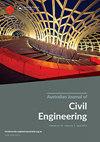Influence of blockaid chairs on compression and out-of-plane behaviour of reinforced masonry walls
IF 1.6
Q3 ENGINEERING, CIVIL
引用次数: 0
Abstract
ABSTRACT Changes in Australian Masonry Standards and National Code of Construction for reinforced masonry (RM) under compression impress the need of a grout annulus and vertical bar confinement using 6 mm tie bars. Maintaining the verticality and centricity of reinforcement and restraining them with the tie bars is challenging and time consuming. BlockAid have designed masonry bar chairs to align and restrain the reinforcing bars central in the block cores. This paper presents an investigation to ascertain the performance of BlockAid bar chairs in supporting the reinforcing bars in the RM walls subject to vertical compression and out-of-plane loads. The mean compressive strength in the fully grouted RM walls with BlockAid bar chairs was determined equivalent to the control specimen which sustained maximum load of 3100kN, compared to 3030kN for the BlockAid sample. Strain in the vertical steel bars, with BlockAid bar chairs, remained compressive throughout the loading with no evidence of buckling. The out-of-plane test results of BlockAid walls were similar in terms of failure modes, load-displacement behaviour and steel strain variations. These observations conclude that BlockAid bar chairs are effective in restraining the vertical bars against buckling and do not compromise the compression and bending capacity of RM walls.砌块椅对加筋砌体墙体抗压及面外性能的影响
摘要:澳大利亚砌体标准和国家建筑规范中关于受压钢筋砌体(RM)的变化,强调了使用6mm拉杆限制灌浆环和垂直钢筋的必要性。保持钢筋的垂直度和中心性,并用拉结筋加以约束,既有挑战性,又耗时。BlockAid设计了砖石钢筋座,以对齐和约束砌块核心中的钢筋。本文旨在确定BlockAid钢筋椅在承受垂直压缩和平面外荷载的RM墙中支撑钢筋的性能。测定了具有BlockAid条形支座的完全灌浆RM墙的平均抗压强度,相当于承受3100kN最大载荷的对照样品,而BlockAid样品的平均抗压力为3030kN。使用BlockAid钢筋座的垂直钢筋中的应变在整个荷载过程中保持压缩状态,没有屈曲的迹象。BlockAid墙的平面外测试结果在破坏模式、荷载-位移行为和钢应变变化方面相似。这些观察结果得出的结论是,BlockAid钢筋椅在抑制垂直钢筋弯曲方面是有效的,并且不会影响RM墙的压缩和弯曲能力。
本文章由计算机程序翻译,如有差异,请以英文原文为准。
求助全文
约1分钟内获得全文
求助全文

 求助内容:
求助内容: 应助结果提醒方式:
应助结果提醒方式:


